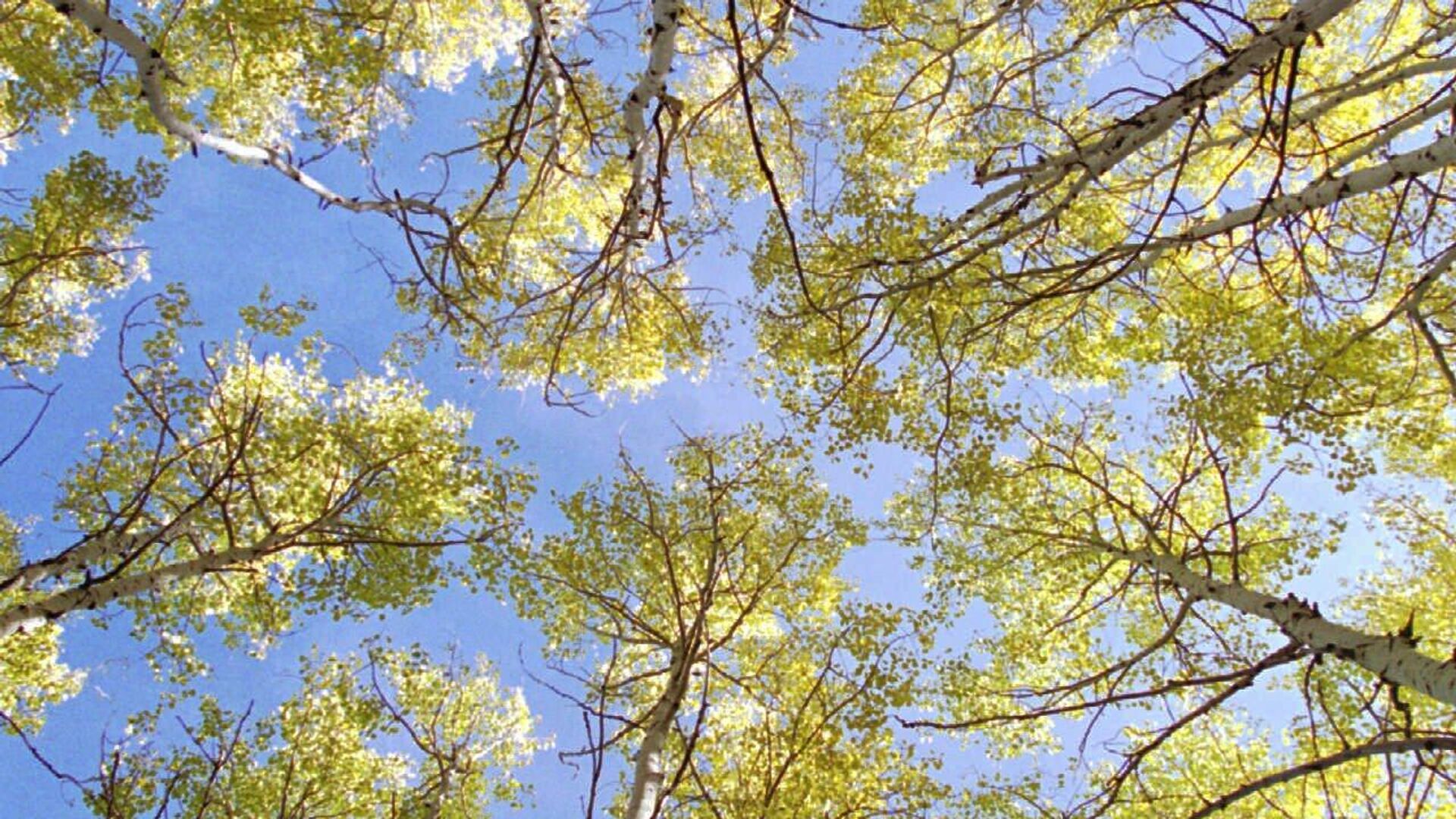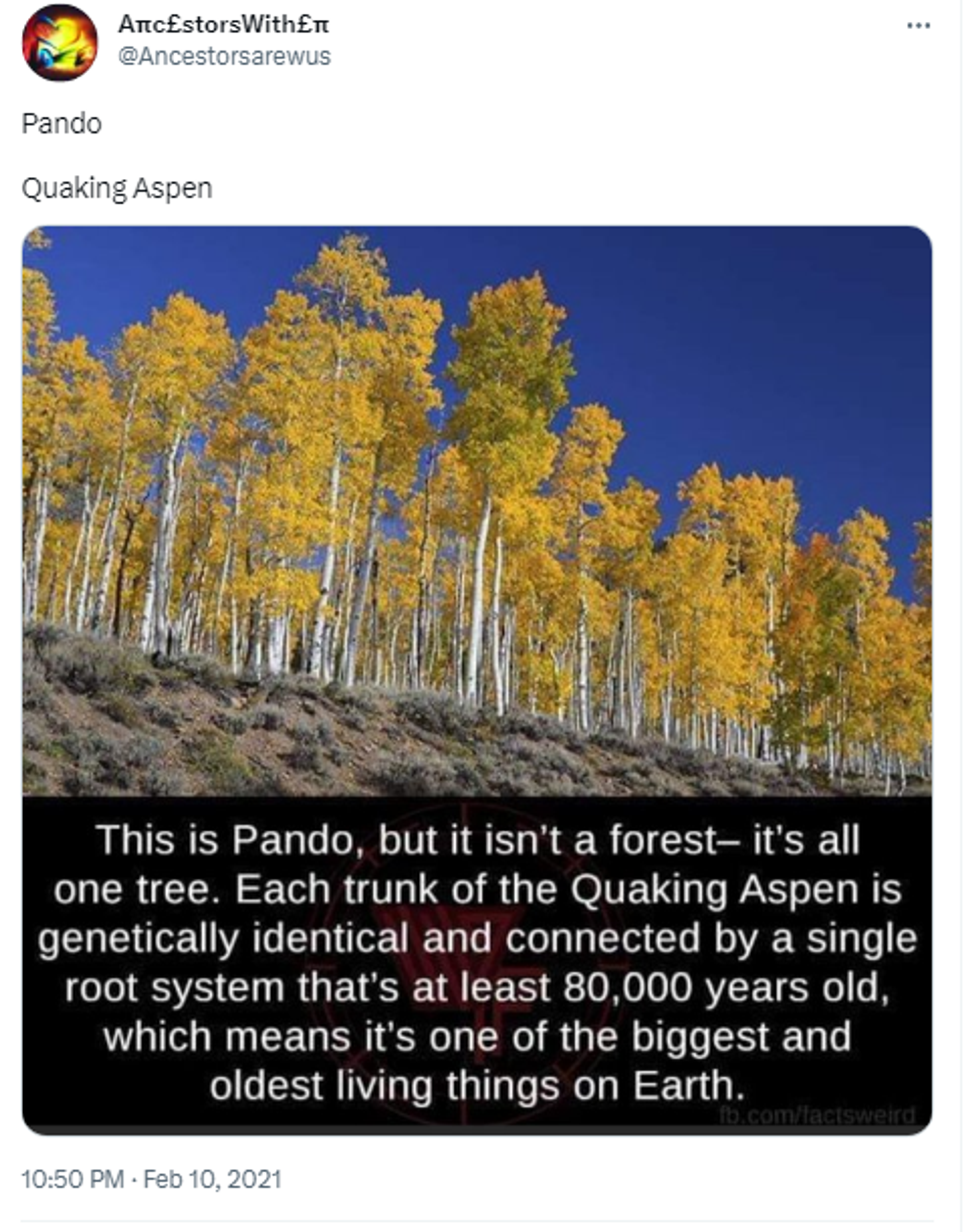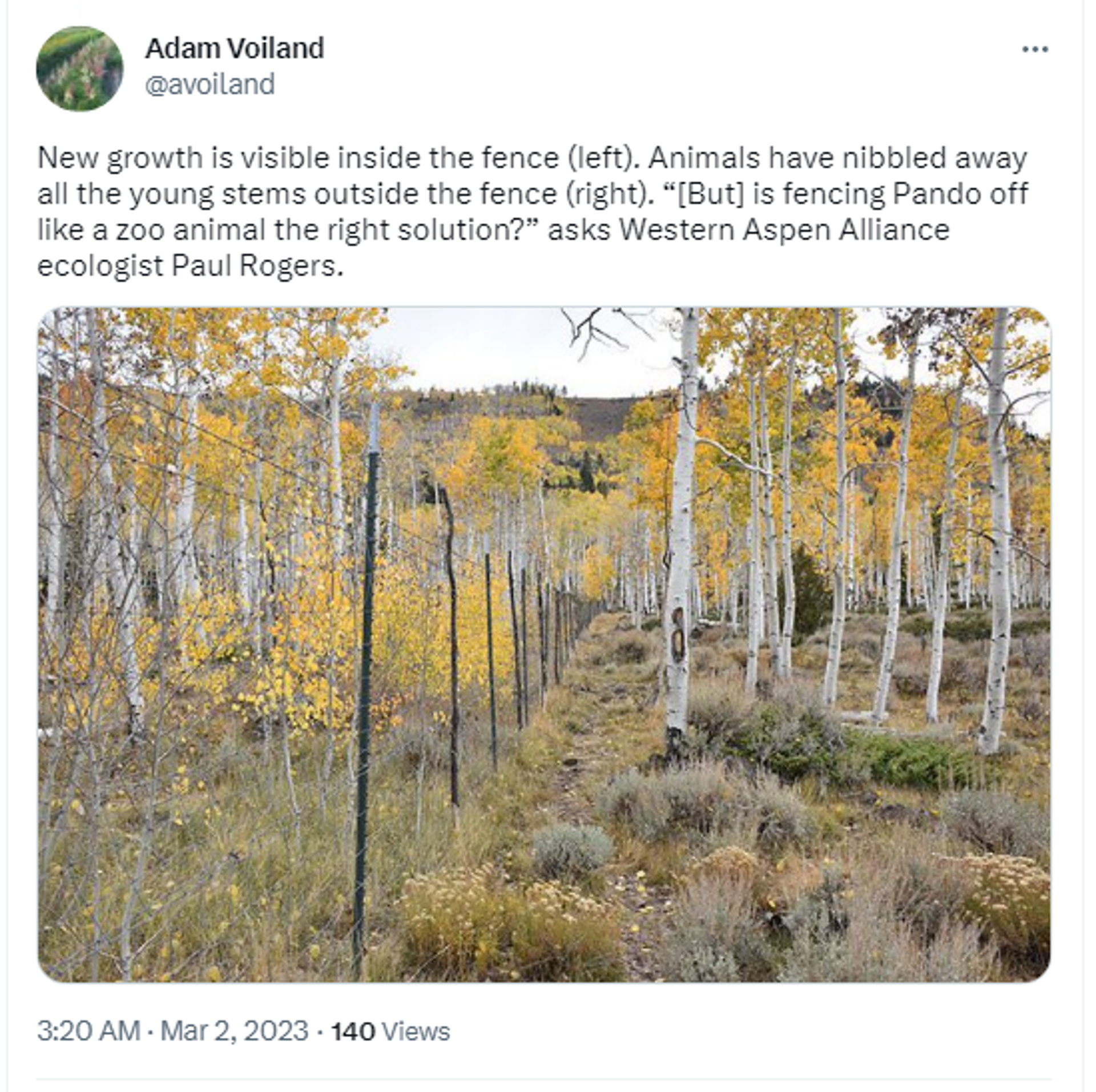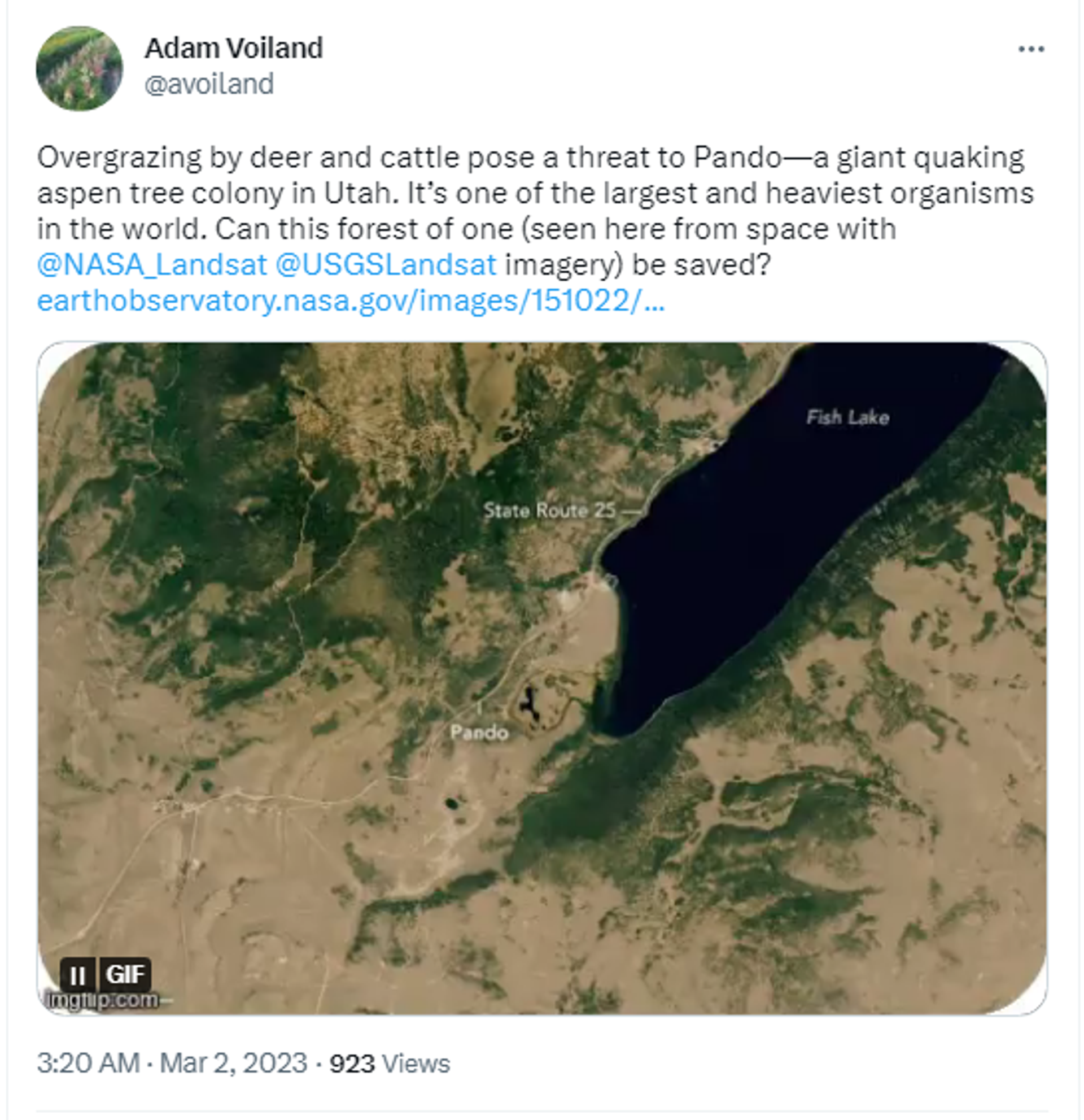https://sputnikglobe.com/20230311/what-is-slowly-but-relentlessly-killing-earths-largest-prehistoric-organism-1108289317.html
What is Slowly but Relentlessly Killing Earth's Largest Prehistoric Organism?
What is Slowly but Relentlessly Killing Earth's Largest Prehistoric Organism?
Sputnik International
One of Earth's largest prehistoric single organisms is slowly being killed, fear ecologists.
2023-03-11T11:41+0000
2023-03-11T11:41+0000
2023-03-11T12:28+0000
science & tech
ecosystem
climate change
tree
aspen
clone
organisms
https://cdn1.img.sputnikglobe.com/img/07e7/03/0b/1108286744_0:640:1280:1360_1920x0_80_0_0_8cf1d0b3c3f445399bf36076a7c4f16e.jpg
Planet Earth's largest single living organism "by mass" - and one of its oldest - appears to be slowly dying, scientists have warned. Furthermore, an entire ecosystem, with plants and animals, is in danger of disappearing with it.Pando, in central Utah and spanning an area of 43 hectares in Fishlake National Forest, looks as though it's simply a horde of quaking aspen, or populus tremuloides. However, what makes it unique is that in actual fact it is just one tree, thousands of years old. The aspen clone has been found to have originated from a single seed. Since then, the seemingly individual trees all grow from the same root system, covering a length of up to 500 meters and a width of up to 120 meters. This unique organism is located at an altitude of 2,697 meters above sea level and comprises about 40,000 trees.The name for the collection of trees, Pando, comes from the Latin word for “I spread”. This collection is not unique, as there are similar clonal forests in other areas. But this one, dubbed 'The Trembling Giant', is particularly impressive. Some of its trees are thought to be around 130 years old.Concerns were first voiced by conservation groups and the US forest service when researchers discovered that the clonal colony estimated to be about 80,000 years old and weighing around 6,000 metric tons hasn't grown for the past 30 to 40 years. Typically, the genetically identical trees spread by sending up new shoots.Now, increasing lack of regeneration, believed to be because of grazing by deer, elk, and cattle, combined with weakening and dying trees, could result in the whole complex dying off. Deer and elk populations, in turn, have soared since numbers of their natural predators - wolves and cougars - diminished. Proof of the unckecked grazing fallout came when one area was fenced off a few decades ago by foresters to remove dying trees. As elk and deer were kept out, new clonal stems were able to regenerate.There are other challenges to Pando, such as dwindling water resources, soaring summer temperatures, threat of wildfires, linked by researchers to climate change.The state's Forest Service has been joining forces with various ecologists and organizations over the years to work out how to help Pando survive, testing ways of stimulating its roots to encourage new sprouting.
https://sputnikglobe.com/20230307/yellen-says-climate-change-will-shock-financial-system-in-coming-years-1108157965.html
aspen
Sputnik International
feedback@sputniknews.com
+74956456601
MIA „Rossiya Segodnya“
2023
News
en_EN
Sputnik International
feedback@sputniknews.com
+74956456601
MIA „Rossiya Segodnya“
Sputnik International
feedback@sputniknews.com
+74956456601
MIA „Rossiya Segodnya“
earth's largest organism, pando, trembling giant, colony of quaking aspen trees, utah, one of the oldest and largest living organisms, about 80,000 years old, fishlake national forest, clonal colony, -individual trees all grow from the same root system, lack of regeneration, grazing by deer, elk, cattle, climate change, wildfires,
earth's largest organism, pando, trembling giant, colony of quaking aspen trees, utah, one of the oldest and largest living organisms, about 80,000 years old, fishlake national forest, clonal colony, -individual trees all grow from the same root system, lack of regeneration, grazing by deer, elk, cattle, climate change, wildfires,
What is Slowly but Relentlessly Killing Earth's Largest Prehistoric Organism?
11:41 GMT 11.03.2023 (Updated: 12:28 GMT 11.03.2023) Dubbed 'The Trembling Giant', a colony of quaking aspen trees in the US state of Utah is believed to be one of the oldest and largest living organisms on our planet, dating back thousands of years. But there are plenty of pretty grim forecasts about its future.
Planet Earth's largest single living organism "by mass" - and one of its oldest - appears to be slowly dying, scientists have warned. Furthermore, an entire ecosystem, with plants and animals, is in danger of disappearing with it.
Pando, in central Utah and spanning an area of 43 hectares in Fishlake National Forest, looks as though it's simply a horde of quaking aspen, or populus tremuloides. However, what makes it unique is that in actual fact it is just one tree, thousands of years old.
The
aspen clone has been found to have originated from a single seed. Since then, the seemingly individual trees all grow from the same root system, covering a length of up to 500 meters and a width of up to 120 meters. This unique organism is located at an altitude of 2,697 meters above sea level and comprises about 40,000 trees.
The name for the collection of trees, Pando, comes from the Latin word for “I spread”. This collection is not unique, as there are similar clonal forests in other areas. But this one, dubbed 'The Trembling Giant', is particularly impressive. Some of its trees are thought to be around 130 years old.
Concerns were first voiced by conservation groups and the US forest service when researchers discovered that the clonal colony estimated to be about 80,000 years old and weighing around 6,000 metric tons
hasn't grown for the past 30 to 40 years. Typically, the genetically identical trees spread by sending up new shoots.
Now, increasing lack of regeneration, believed to be because of grazing by deer, elk, and cattle, combined with weakening and dying trees, could result in the whole complex dying off. Deer and elk populations, in turn, have soared since numbers of their natural predators - wolves and cougars - diminished. Proof of the unckecked grazing fallout came when one area was fenced off a few decades ago by foresters to remove dying trees. As elk and deer were kept out, new clonal stems were able to regenerate.
There are other challenges to Pando, such as dwindling water resources, soaring summer temperatures, threat of wildfires, linked by researchers to
climate change.
The state's Forest Service has been joining forces with various ecologists and organizations over the years to work out how to help
Pando survive, testing ways of stimulating its roots to encourage new sprouting.





